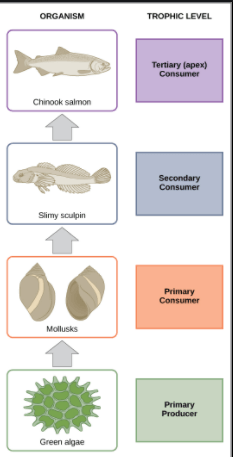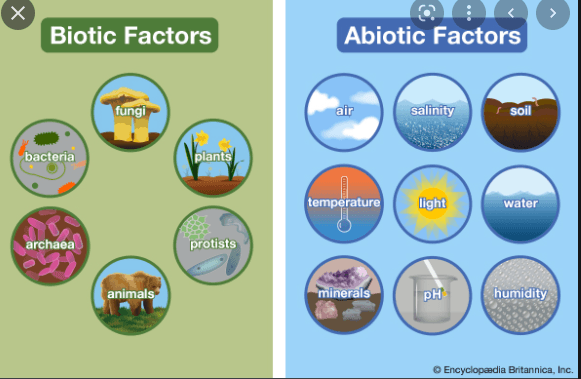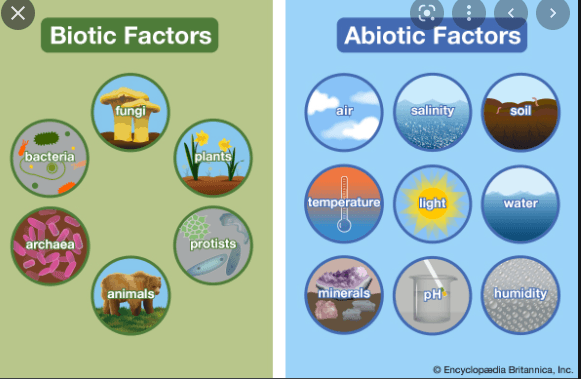Does the arrow points to the animal getting energy or the animal giving energy?
What is the animal getting the energy.
How many major biomes are there?
What are there are 5 major biomes
What is a producer and why?
What are plants because use photosynthesis to produce glucose and oxygen.
Which of the following is abiotic? water, fish, people or frogs
What is water.
What are ecosystems made up of?
What are all abiotic and biotic factors in an area.
Define Species
What is a A group of similar organisms whose members can mate with one another and produce fertile offspring
Where does the Mollusk get there energy from? 
What is the Algae
What biome has extremely dry environments that are home to well adapted plants and animals?
What is a desert.
What is an omnivore?
What is an animal or person that eats food of both plant and animal origin.
Is aboitic the living or non-living part of the ecosystem?
What is the non-living part.
What is a niche?
What is the role an organizm plays in a community.
Define Competition
What is where Organisms compete for the limited number of biotic and abiotic factors
Which of these is a biotic producer? Sun, Plants, Bear, Water.
What are Plants
What biome do Zebras live in?
What is a grassland or a Savanna.
What is a herbivore?
What is an animal that feeds on plants.
What kind of consumers are needed in an ecosystem for balance to occur?
herbivores, carnivores, omnivores, decomposers
How is an ecosytem an example of a system?
An ecosystem is like a system because it has living and nonliving parts. Those parts work together for a common purpose of survival. they are in balance with each other.
Define a heterotroph?
A heterotroph is an organism that cannot produce its own food, instead taking nutrition from other sources of organic carbon, mainly plant or animal matter. In the food chain, heterotrophs are primary, secondary and tertiary consumers, but not producers.
Which uses photosynthesis a consumer or a producer?
What is a producer
What biome does a maned wolf live in?
What is the South American Grasslands.
A consumer gets energy by doing what?
What is Feeding on other organisms.
Name 4 Biotic Factors

The term “ecosystem” was first proposed in 1935 by who?
What is the British ecologist A. G. Tansley
Define Autotroph.
An autotroph is an organism that can produce its own food using light, water, carbon dioxide, or other chemicals. Because autotrophs produce their own food, they are sometimes called producers
What animals do Minks prey on most Commonly?
What are frogs small birds
List and describe 5 types of major terrestrial biomes.
- Desert: Receives less than 10 inches of precipitation per year. Can reach very high temperatures well above 100 degrees F, and is a very dry landscape. Deserts don't support abundant plant life.
- Arctic Tundra: Also very dry, less than 10 inches of precipitation per year, but extremely cold as well. Found in Arctic regions of the Earth, and no trees are found here. Living organisms must be very hardy in order to live in this area.
- Boreal Forests: Receives 15-39 inches of precipitation per year and is found in the Northern latitudes. Predominantly covered with coniferous trees and has cool summers and cold winters. Supports many types of plant life.
- Grasslands: Receive about 10-30 inches of precipitation per year and grass is the predominant vegetation in this biome. This type of biome is found in central North America, and many large grazing animals are found here.
- Savanna: Receive about 4-16 inches of precipitation per year and vegetation is mainly grass and scattered trees. Found in hot areas which are also tropical.
Ecological pyramids show the relative amount of energy or matter contained within each trophic level in a given food web. True or False
What is True
Name 6 Abiotic factors

Are nonliving components of an ecosystem important?
Nonliving components are very important. Air is nonliving. Air contains oxygen which organisms need to breath to live. Air also contains carbon dioxide. Plants need carbon dioxide to produce their food. The sun is nonliving. Plants need the sun to produce their food. Animals need the sun for the heat it provides.
What is the difference between a food chain and a food web?
Food chain - A series of events in which one organism eats another. One of three ways in which energy moves through an ecosystem.
Food web - The pattern of overlapping food chains in an ecosystem. One of three ways in which energy moves through an ecosystem. A model of feeding relationships.